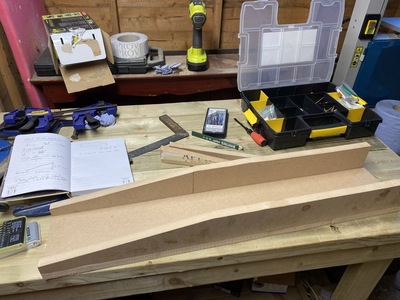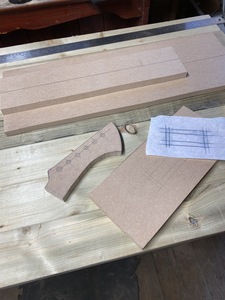Practice on scrap...
You are not wrong.
Shame there's no edit button 🙂
Too be fair I started by cutting the MDF for both and ended up finishing the headstock angle first.
I know what you mean about that edit button, it’s just sitting there... mocking you.
Your jig looks great btw, let’s see some more.
Practice on scrap...
Thanks @clinton
Did some more template work today, need to pick up some smaller screws for the actual neck angle.
Cheers for answering my head stock questions on the live stream @markbailey
In answer to your question 'how big is this headstock anyway?' it's here above, obviously under the thread entitled 'Neck Angle Jig done' where I show my headstock angle jig done.
Sometimes I really do think I'm putting your 'any idiot can build a guitar' theory to the test.
Sometimes I really do think I'm putting your 'any idiot can build a guitar' theory to the test.
That theory has been tested many times ... I've got the guitars to prove it
😋
Online guitar making courses – guitarmaking.co.uk
And I’m gearing up to prove it!
Practice on scrap...
Sometimes I really do think I'm putting your 'any idiot can build a guitar' theory to the test.
@cheesewhisk We are all in the same boat, we all have proof. 🤣
Sometimes I think my workshop should just be called Boo’s Repair Shop because there are times when all I seem to be doing is repairing the mistakes I made the day before. 🤣 It’s all part of the fun. 👍
Make guitars, not war 🌍✌️🎸
@boo and that's why I love this place.
I'm still laughing at the fact the first real job is to route the neck blank, I have a shiny new router, my first router and the first thing I'm meant to do is attack the neck with it?? I think I might practice a bit on some scrap 🙂
I think I might practice a bit on some scrap
That's a good idea. Most of my cockups were with me getting carried away with the router. Having said that, my bit of practice scrap turned into a guitar that I love. Part of the challenge is fixing the mistakes. Have fun.
Practicing on scrap is one of the most important golden rules! I learned that chunk of wisdom from the mighty Dan Erlewine but it took me a while to actually implement it. 😂
I’ll admit to cursing myself a few times for not doing just that on some of my early customer guitars😬😬😬.
But the silver lining was learning new skills to correct the mistakes that I’d made, however I DO NOT recommend customer guitars as the way to develop those skills so please, pratice on scrap!
I’m fairly certain that you aren’t working on other people’s guitars but the point stands.
Remember that the router is a very dangerous and unforgiving tool, please get some instruction before using one if you haven’t already.
Personally it’s one of my favorite tools, it’s such a beast and I enjoy using them. However it’s very easy to make a mistake/have an accident so always keep in mind the direction that the bit is spinning! You want to move the router against that direction so the router doesn’t skate away from you!
Apologies if you already know this stuff...
Have fun!
Practice on scrap...
@mattbeels no apologies needed, this is why I love this site. I have a very healthy fear/respect for all the tools I've picked up for this adventure. I've spent time learning how to use the bandsaw before ever even switching it on and that's exactly the reason I've not even unpacked my router yet, I want to do way more homework so all and any advice is definitely welcome.
Things I've picked up so far:
- Direction is very important - go counter clockwise - the opposite way that the router is spinning (like you said)
- Depth is important, do multiple smaller passes rather than too deep at once
- Set the stop gauge
- Do not put the router down until it stops spinning
- Always switch it off before changing bits
- Always treat the router as though it's live
Direction is very important - go counter clockwise - the opposite way that the router is spinning
Just be careful with your direction. When you're routing a control cavity for instance, thats an internal cutout, so you would move your router clockwise, same direction of tool rotation. You want to be moving the cutting edge towards the cut. Going the wrong way, the tool can sometimes climb over the workpiece, and as Matt says, can run away with you. I hope I'm right in what I'm saying here, someone please correct me if I'm wrong.
You are correct.
Cutting a hole like a control cavity or for a pickup would be done clockwise. Profiling and rounding over a body would be done counter clockwise.
Practice on scrap...






